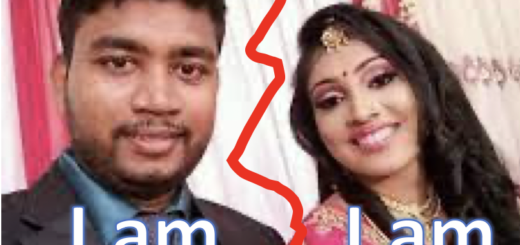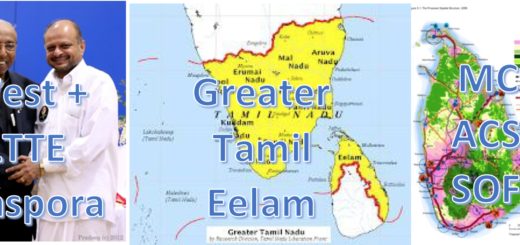Self-Determination for the Sinhalese as a distinct ethnic group with a distinct language
It is time the Sinhalese asserted their rights. It is time the world knew the history & heritage of the Sinhalese – people found nowhere else but in the Sinhale nation, people who had a distinct language, distinct culture & customs. One of the first myths that need to be cleared is that the Sinhalese do not descend from the bandit Vijaya. There was a very active civilization existing in every nook & corner of the island before the supposed arrival of Vijaya. The civilizational history thereafter ushered in dynastic periods with many wonders & marvels that solidified a Sinhala Buddhist history & heritage. In such a scenario if anyone should be seeking self-determination it is the Sinhalese of the whole island which was occupied by them. However, the Sinhalese are not saying ONLY the Sinhalese want to have the island as their own & to their own but the Sinhalese are saying that Sinhalese are happy to live with the other communities who have come later & made the island their home SO LONG AS they do not seek to create mono-ethno-religious territory dividing the island on bogus lines.
Working backwards we are all in unison that some 1.5 million years ago the human beings first began to evolve in Africa. Cradle of that history is in Tanzania an area known as Gondwanaland which later became India, Australia, and South America. There is therefore no pure ethnic group and only the original Africans can claim to be 100% pure. ‘Ethnic’ name tags was coined by Western Europeans to suit their divide & rule policies.
At the time of decolonization, it was these Western rulers who created the international laws that every nation was to be subject to. None of the customs, laws, traditions that existed from the first civilization & there onwards prior to Western hegemony were taken to consideration in framing international laws. It is unfortunate that issue is being argued on the white perception of laws & Western concepts of governance. Thus self-determination which was meant to be the right of countries to regain their lost nations with years & because of modern imperial notions was turned into internal self-determination / external self-determination and with years every term became recoined depending on the political requirement – same has become with the term federalism which is now even promoting asymmetrical federalism, again to suit the agendas of those promoting it. The political determination of self-determination thus came during the Kosovo conflict to fast-forward Western imperial motive & awarded Kosovo independence the outcome which has now proved a failure a case repeated in South Sudan too.
Tamils will draw similarity to the Aland Islands that was culturally & linguistically Swedish territory & wished to reunite with its motherland Sweden rather than Finland. Tamil Nadu (state for Tamils) in India mooted the quest for self-determination at the time Colonial Britain was about to given independence to India arguing that Tamil Nadu was never part of the pre-colonial British India. Tamils in Sri Lanka are also culturally & linguistically linked to Tamil Nadu – they speak the same language, have the same Tamil ethnicity & their anatomy also is identical which is not the case with the Sinhalese. The concern has been that the demand for self-determination in Sri Lanka is inadvertently linked to a future claim to plug it to Tamil Nadu whereby a key area of sovereign Sri Lanka may end up becoming part of India.
What cannot be brushed aside is that the quest for self-determination is identical to the separatist claims by the LTTE terrorists & their fronts, another key reason why any government should think twice to even agree to such a request. Moreover, even the UN charter is clear that self-determination cannot disrupt national unity & territorial integrity. The case of Aland islands is therefore pertinent to Sri Lanka too.
Within these hypocrisies that we are arguing the case of the Sinhalese whose island nation was illegally occupied. What right do illegal occupants have to give ‘independence’ to a nation they occupied illegally.
The island was known by many names – Sihala deepa, Thambapanni, Hela, Sinhale.
Synonymous with the island Sinhale are the Sinhalese or the Sivu Hela comprising 4 tribes – Raksha, Yaksha, Naga & Deva. With time Sivu Hela became Sinhale. The discoveries of inscriptions in Badungala in Galle proves their ability to write. Further inscriptions found in Alawwa, Ambilikande & Mawanella showcases the civilizational heritage of the Sivu Hela people. More importantly the dates of these findings are important as they go back tens of thousands of years which invariably proves the existence of the Sinhala people. There were humans living on the island when bandit Vijaya and men landed. Kuveni belonged to that Hela dynasty.
Human remains have been found in Pathirajawela in deep South, Bundala, Fa Hien Caves which date back 37,500 BCE, Balangoda Man (Batadombalena cave) was found in Kuruwita dating 28,500BCE. Belilena cave in Sri Lanka, located near Kitulgala showed prehistoric human presence as early as 32,000 years ago.
By 28,500BCE people were living in small family units throughout the island
Sinhalese have much to be proud of
- 28,500 BCE – Beads of shells, burying dead underground (Ravana Ella, Fahien caves)
- 27,000 BCE – using salt
- 15,000 BCE – agro subsistence, pollen evidence from Horton Plains for farming, use of necklaces & needles found in Embilipitiya
- 12,000 BCE – steel, copper, irrigation technology in Maduru Oya
- 6300 BCE – pottery found in Kegalle (Dorawaka-lena)
- 6000 BCE – Mahamevuna Uyana – a huge city that existed in Anuradhapura, which even used horses (bandit Vijaya arrived only in 543BCE)
- 5000 BCE – discovery of grinding stone, rough clothing, fireplace indicating origins of Mahasona beliefs (Pallemala)
- 4000 BCE – small family units increased to large settlements in towns adopting agriculture & metal
- 3500 BCE – inventing boats (water-based transport system) that could carry 150 passengers (Attanagalla Oya)
- 1000 BCE – iron (steel) technology replacing stone technology
- 900 BCE – use of alphabet
- 900 BCE – discovery of a major town extending 25 acres in Anuradhapura, by 700 BCE this area increased to 125 acres.
- 600 BCE – first Brahmi letters
- 564 BCE – Sivu-hela (Simhala) communities divided into 4 tribes
- 543 BCE – bandit Vijaya arrived
- 380 BCE – Anuradhapura kingdom for 1400 years
- 250 BCE – Buddhism becomes state religion
- 245 BCE – bhikkhuni Sangamitta arrived with the Jaya Sri Maha Bodhi tree
Late Minister Cyril Mathew in a letter to UNESCO has listed all places of Buddhist worship in both North & East of Sri Lanka with dates & this clearly establishes the Sinhala Buddhist heritage of the areas that are being demanded as a mono-ethno religious area. If Sinhala Buddhists had been living in these areas it rightfully establishes their rights to self-determination of these areas as well. http://www.jaffnahistory.com/Cyril.pdf
There are plenty of historical evidence to prove Sinhalese were living in the areas being claimed as mono-ethno-religious territory and being flagged by countries using the minorities for their own geo-political agendas.
Not only can Sinhalese prove a timeline of existence in every nook & corner of Sri Lanka, the Sinhalese can show that they created water systems nowhere found, irrigation systems, magnificent cities, laws & customs, royal edits, cultural traditions, a unique language found nowhere else other than Sri Lanka… and none of these can be matched by those claiming self-determination to showcase that they were running separate & independent state.
When the Sinhalese have enough of evidence to showcase they were very much living in the areas that are being claimed & demanded as a separate territory, the international community have NO MORAL RIGHT to brush aside the evidence placed by the Sinhalese & instead hand over an independent territory to the Tamils who are only shouting slogans minus any solid proof.
When the Portuguese, Dutch & British landed & illegally occupied the island the Kandyan Convention of 1815 was signed with the Sinhale Nation not any other supposed to be independent areas of the island. Therefore, the unanswered question is why was independence not given to the Sinhale Nation and instead independence was given to ‘Ceylon’ a name coined by the British which did not exist in 1815.
Therefore, at the next UN & UNHRC sessions the delegations that are defending the Nation & its National Army must put forward the case for Sinhalese claims to Self-Determination with the operational inclusion that while Sinhalese have a right to claim the entirety of the island by virtue of living in every nook & corner since time immemorial, the Sinhalese are more than happy to live with the other communities in the island so long as they do not seek to divide or separate the island.
Shenali D Waduge







